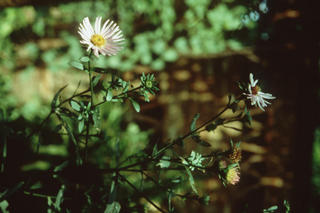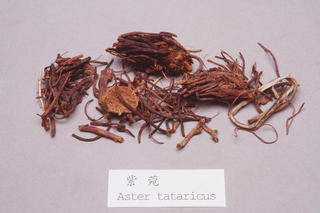Aster tataricus
Contents
Nomenclature
Other Names:
Historical Use of Aster tataricus
Aster tataricus in Traditional Chinese Medicine
Background
Zhiziwan ÖË×ÏÝÒ
Chinese Name (pinyin): Ziwan
Chinese Name :
Common Name :Root and Rhizome of Tatarian Aster
Specific Name : Radix asteris
Scientific Name:
Collection : The drug is collected in spring and autumn, removed from the knotty rhizomes and soil, braided and dried in the sun or dried in the sun directly.
Description : Rhizome in irregular masses, varying in size, apex with remains of stem and leaves. Texture slightly hard. Rhizomes bearing numerous, fascicular rrotets, 3 - 15 cm long. 0.1 - 0.3 cm in diameter, frequently braided. Externally purplish red or greyish red with longitudinal wrinkles. Texture flexible. Odour, slightly aromatic, sweet and slightly bitter.
Identification : 1.Transverse section of root: Epidermal cells frequently withered or sometyimes sloughing, containing purplish red pigment. Hypodermal cells in a row, somewhat elongated tangentially, some containing purplish red pigment, lateral and inner walls slightly thickened. Cortex broad with intercellular spaces, secretory ducts 4 - 6 in cortex inside, endodermis distinct. Etele small, xylem somewhat polygonal, each of the phloem bundles alternating with the arc of xylem respectively, the center usually showing a pith.Rhizomes: Epidermis with glandular hairs, cortex scattered stone cells and sclerenchymatous cells. Parenchymatous cells of root and rhizomes containing inulin, sometimes containing clusters of calcium oxalate.2.Heat 2 g of the powder in 20 ml of water at 60ºC on a water bath for 10 minutes, filter while hot and allow to cool. Transfer 2 ml of filtrate to a stoppered tube, shake vigorously for 1 minute, a persistent froth is produced lasting for 10 minutes.3.To 2g of the powder add 20 ml of petroleum ether (60 - 90ºC), heat under reflux for 30 minutes and filter. Evaporate the filtrate to about 2 ml, used it as the test solution. Prepare a solution of 2g of Radix Asteris reference drug in the same manner as the reference drug solution. Carry out the method for thin layer chromatography (Appendix Vl B0, using silica gel G as the coating substance and benzene as the mobile phase. Epply 2 µl of each of the solutions to the plate. After developing and removal of the plate, dry it in the air, spray with 2.4-dinitrophenylhydrazine TS. The yellow spots in the chromatogram obtained with the test solution correspond in position and colour to the spot in the chromatogram obtained with the reference solution. Heat the plate at 105ºC for 10 minutes, the spots in the chromatogram obtained with the test solution correspond in position and colour to the spot in the chromatogram obtained with the reference solution.Total ash: Not more than 15.0% (Appendix lX K).Acid-insoluble ash: Not more than 8.0%
Processing : Eliminate foreign matter, wash clean, soften briefly, cut into thick slices and dry.Stir fried with honey: Stir fry the slices as described under the method of stir frying with honey (Appendix ll D) until no more sticky to fingers.
Action : To eliminate phlegm and relieve cough.
Indication : acute or chronic cough and asthma with copious expectoration; hemoptysis in consumptive diseases
Precautions :
Dosage : 4.5 to 9 g.
Storage : Preserve in a cool and dry place, protected from moisture.
Synonymns for Aster tataricus
Patent Medicines and Medicines with Multiple Ingredients that include Aster tataricus
Pharmaceutical Information
Chemical Constituents
Evidence or the Use of Aster tataricus in the Treatment of Epilepesy
Basic Science
Animal Studies
Cohort, Case-Control and Non-Randomized Trials
Randomized Controlled Trials
Meta-Analysis
1st Five Results: pubmed search
Chang-Seob Seo
Simultaneous Quantification of Nine Target Compounds in Traditional Korean Medicine, Bopyeo-Tang, Using High-Performance Liquid Chromatography-Photodiode Array Detector and Ultra-Performance Liquid Chromatography-Tandem Mass Spectrometry.
Molecules: 2024, 29(5);
[PubMed:38474683]
[WorldCat.org]
[DOI]
(I e)
Jian-Li Li, Chao Chen, Min-Jie Ma, Pei Li, Si-Qi Yang, Rui Guo, Chun-Lei Zhang, Yan-Gang Cheng
Five new secondary metabolites from Aster tataricus.
Fitoterapia: 2024, 174;105828
[PubMed:38296166]
[WorldCat.org]
[DOI]
(I p)
Xiaodong Yan, Xiaoyun Tong, Yongrui Jia, Yi Zhao, Qiushi Zhang, Min Hu, Xiaohong Li, Baojing Li, Xi Ming, Yuhuan Xie, Xiangnong Wu, Xiaoling Yu, Lu Qu, Lei Xiong, Feng Huang, Jian Nie
Baiheqingjin formula reduces inflammation in mice with asthma by inhibiting the PI3K/AKT/NF-κb signaling pathway.
J Ethnopharmacol: 2024, 321;117565
[PubMed:38081397]
[WorldCat.org]
[DOI]
(I p)
Sung-Ju Lee, Hyun Yang, Seong Cheol Kim, Dong Ryun Gu, Jin Ah Ryuk, Seon-A Jang, Hyunil Ha
Ethanol Extract of Radix Asteris Suppresses Osteoclast Differentiation and Alleviates Osteoporosis.
Int J Mol Sci: 2023, 24(22);
[PubMed:38003715]
[WorldCat.org]
[DOI]
(I e)
Yahui Dong, Yang Liu, Jie Tang, Jiahui Du, Xuzhen Zhuang, Song Tan, Ye Yang, Dengke Yin
Zhisou powder displays therapeutic effect on chronic bronchitis through inhibiting PI3K/Akt/HIF-1α/VEGFA signaling pathway and reprograming metabolic pathway of arachidonic acid.
J Ethnopharmacol: 2024, 319(Pt 1);117110
[PubMed:37673198]
[WorldCat.org]
[DOI]
(I p)

